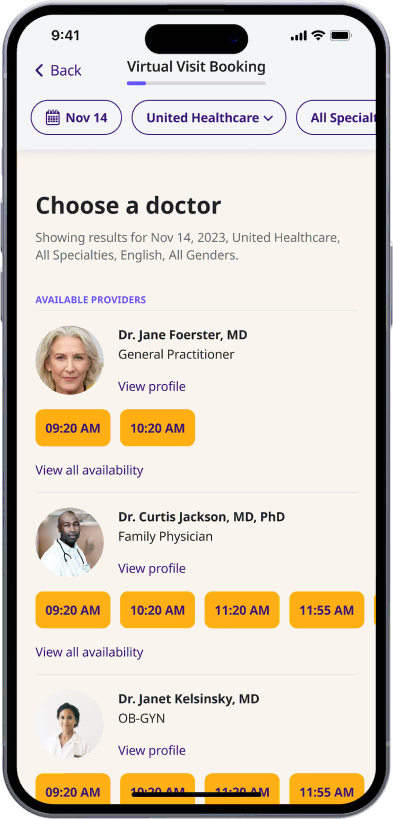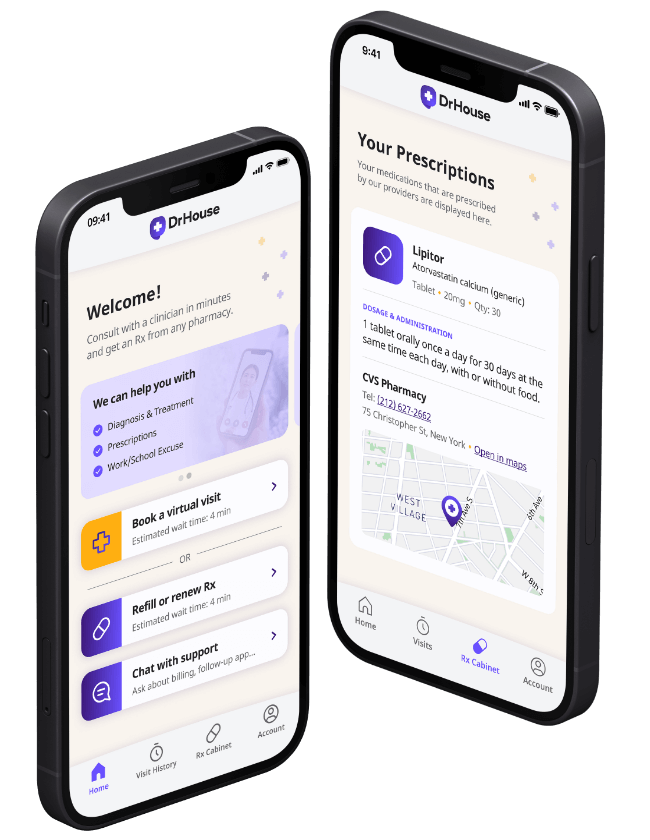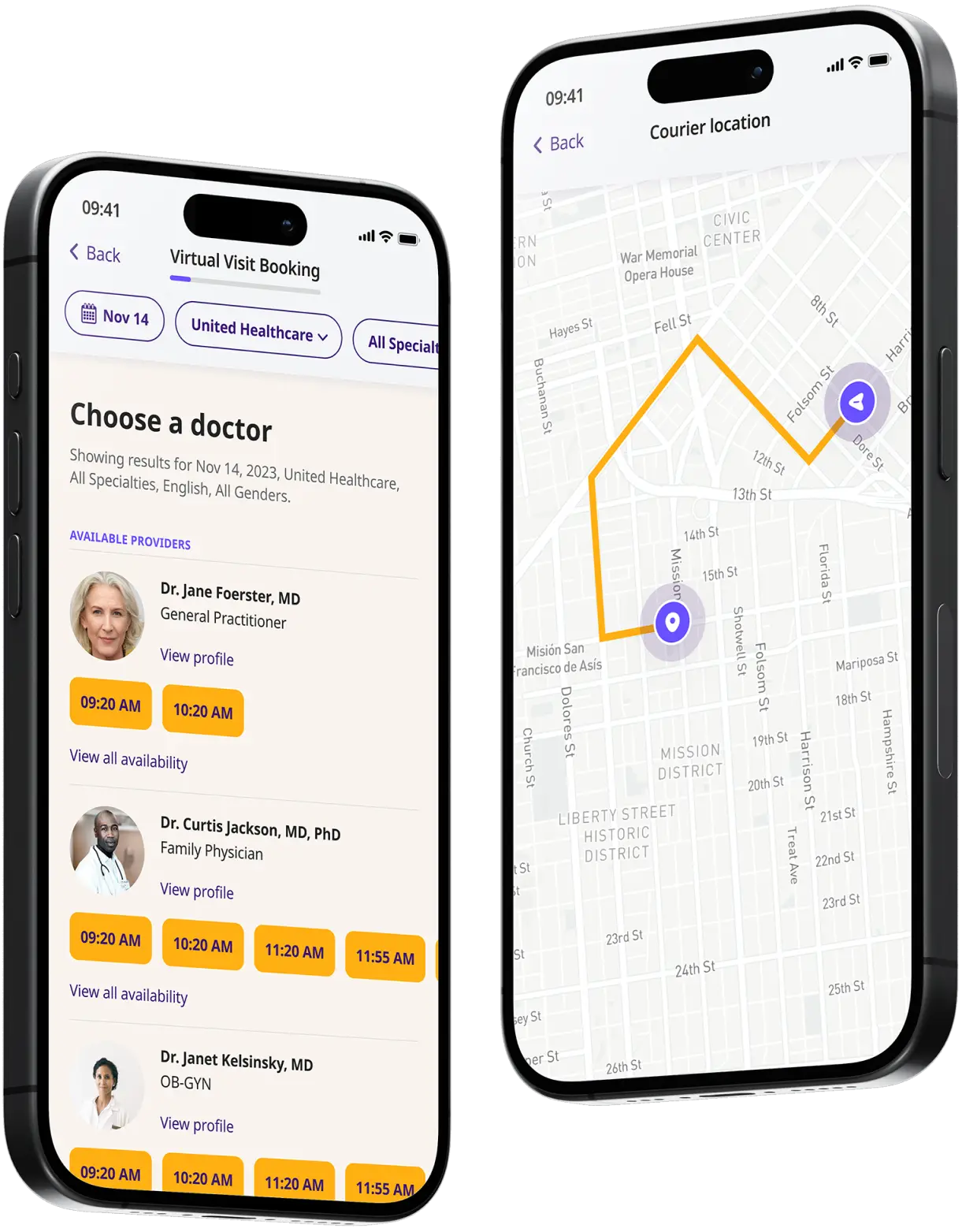Get a Hydrocortisone Prescription Online
Get a new hydrocortisone prescription or refill your medication online.


Available in 50 states. Insurance accepted.
Fast
virtual visits
24/7 care
assistants
Prescriptions
as needed

24/7 Personal Care
Consult with a physician in 15 minutes, refill an Rx or chat with our care assistants.

Affordable & Convenient
See your cost upfront and get treatment for hundreds of different conditions.

Insurance Accepted
We accept most major insurance plans, making healthcare easy and affordable.
See If Delivery Is Available Near You
Delivery Not Available
Enter your ZIP code to check if prescription delivery is available in your area and how soon your meds could arrive.
How to get started
Choose your doctor, start a virtual visit, and have your prescriptions sent to your preferred pharmacy for pickup — all in just a few easy steps.
Choose a doctor
Choose a physician by availability, specialty, ratings, and more.

Start your video visit
Connect with a doctor in minutes on a secure video call.

Get your prescription
Pick up your meds or have them delivered in as little as an hour.

Available in 50 states. Insurance accepted.
One-Time
Physician Visit
One-time visit with a physician for diagnosis, treatment, Rx, labs, referrals, and doctor’s notes.
Accepted Insurances
See why people turn to DrHouse...
As seen in

Hydrocortisone
What Is Hydrocortisone?
Hydrocortisone is a type of corticosteroid that’s prescribed as a topical cream. It is chiefly used to combat a multitude of skin conditions that cause redness and swelling. The purpose of Hydrocortisone is to reduce inflammation in the afflicted area, which will decrease the signs of redness.
You will find Hydrocortisone under a plethora of brand names, including Cortizone, Corticaine, Hydroskin, and more.
How Does Hydrocortisone Work?
This drug works by suppressing the immune system and decreasing the body’s inflammatory response. Swelling and redness appear on the skin due to the immune system responding to particular conditions. This is a natural defense response, but sometimes it can lead to too much inflammation.
Hydrocortisone is a corticosteroid, which is a special type of medication that targets inflammatory genes. It suppresses these genes and helps them turn off, meaning the immune system no longer triggers an inflammatory response.
Because Hydrocortisone is provided as a topical cream, it will specifically target inflammation when applied to part of your body. Therefore, it reduces inflammation in this particular area, which will calm down many common symptoms associated with inflammatory skin conditions.
What Is Hydrocortisone Used For?
Hydrocortisone is used for multiple symptoms and a selection of skin conditions. Some common skin conditions treated by this medication include:
- Eczema
- Dermatitis
- Allergic rashes
- Psoriasis
- Nappy rash
- Insect bites/stings
When used, Hydrocortisone will specifically target the following symptoms:
- Redness
- Swelling
- Itching
This medication is only for use on your skin so should not be applied orally. Hydrocortisone should also not be used for any facial skin conditions. You may suffer from some of the skin problems mentioned above, but if they affect your face you will need to seek different treatment. Hydrocortisone can have severe side effects when used on your face as the skin is more sensitive. Likewise, you should avoid applying it under your arms unless explicitly directed to by a doctor.
What Are The Side Effects Of Hydrocortisone?
Topical creams or ointments typically cause a wide range of potential side effects when applied to patients. Hydrocortisone is no different, with a handful of common and rare side effects present.
Common side effects are nothing to be concerned about as they usually clear up quickly. These are some of the more mild symptoms to be on the lookout for:
- Acne growth
- Mild skin irritation
- Excess hair growth
- Changes in skin color
- Small red bumps on the skin
- Dry skin
Give your body a chance to adapt to Hydrocortisone when you start using it. If these side effects are still present after a couple of weeks, talk to a doctor. If they keep getting progressively worse, stop using Hydrocortisone.
While very rare, there have been some severe side effects of Hydrocortisone noted:
- Excessive redness
- Excessive swelling
- Skin infections
- Severe rashes
- Allergic reactions
You must make a note of these severe side effects as you should speak to a doctor as soon as you notice them. There is a chance you’re suffering a bad reaction to the medication – or you may be applying it incorrectly. Either way, your doctor will explain the next steps so you can reduce these side effects and avoid making them worse.
How to Take Hydrocortisone?
Hydrocortisone is only used externally and you should avoid contact with your mouth or face. You will receive a tube with this cream inside when obtaining your prescription. Your doctor will go over the correct dosage amounts and how frequently you need to apply it to your skin. Pay attention to them and read the informational booklet that comes with your Hydrocortisone to know how much to apply each time.
Applying this medication is relatively simple. You squeeze out the required amount and rub it into the affected area. Keep this area clear so the Hydrocortisone can settle in and be more effective. Avoid covering this area or bandaging it up – unless your doctor tells you to.
When obtaining a Hydrocortisone prescription, you will be told how long to use this medication. Do not exceed the recommended duration as you could end up with mild or severe side effects. At the same time, avoid using Hydrocortisone on healthy skin. It is designed to treat inflammation, so use on healthy skin can trigger side effects.
Improvements in your skin are typically seen within a couple of weeks of regular use. If your symptoms do not abate, speak to your doctor and explain how you are using the medication. They might recommend using Hydrocortisone more frequently or could seek out another medication for you to try instead.
Frequently Asked Questions About Hydrocortisone
Who Should Not Take Hydrocortisone?
Hydrocortisone is not recommended for those who:
- Who has an infection – Hydrocortisone can suppress the immune response, making it more difficult for the body to fight off an infection.
- Allergic to it – People who have had an allergic reaction to hydrocortisone or any of its ingredients in the past.
- Those who suffer from diabetes – Hydrocortisone can affect blood sugar levels, so this medication should be avoided by those who suffer from diabetes.
Those are just some examples and you should consult with a doctor before taking Hydrocortisone.
What Is the Most Common Side Effect of Hydrocortisone?
The most common side effects of topically applied Hydrocortisone are dryness, redness, and irritation of the skin. Other common side effects can include thinning of the skin, changes in skin color, increased hair growth, and acne.
For tablet forms of Hydrocortisone, the most common side effects may include nausea, vomiting, stomach pain, diarrhea, and headaches.
It’s important to be aware of these side effects and contact your doctor if they become severe or persist.
What to Avoid While Taking Hydrocortisone?
While taking Hydrocortisone, you should avoid the following:
- Other topical steroids such as hydrocortisone acetate, fluocinolone acetonide, and clobetasol propionate.
- Alcohol – If you take Hydrocortisone tablets, alcohol can increase some of the side effects and it can be burdening on your liver.
- Live Vaccines: If you are on systemic hydrocortisone, especially at higher doses, you should avoid live vaccines. Hydrocortisone suppresses the immune system, which can make live vaccines riskier or less effective.
- Certain Medications: Hydrocortisone can interact with a variety of drugs. Inform your doctor about all the medicines you are taking, including prescription drugs, over-the-counter medications, vitamins, and herbal products. Some medications might increase the effects of hydrocortisone, while others may decrease its effectiveness.
The listed things above are just some examples of things you should avoid and there may be more. Be sure to consult with a doctor about any other potential things you should avoid while taking Hydrocortisone.
How Long Does It Take for Hydrocortisone to Work?
When using Hydrocortisone creams or ointments, it usually takes a few hours to start noticing relief from itching and inflammation. Significant improvement may be observed within a few days.
When taken orally, Hydrocortisone takes anywhere from a few hours to a day.
It’s important to note that the effects of Hydrocortisone may be different for everyone and the actual time it takes to start experiencing symptom relief may vary.
It’s important to use Hydrocortisone cautiously and consistently as directed by your doctor to get the best results.
What Is the Typical Dosage for Hydrocortisone?
The typical dosage for Hydrocortisone cream or ointment will vary depending on the condition being treated.
Usually, Hydrocortisone creams contain 1% hydrocortisone and should be applied one to four times a day. For tablets, the usual dose is 20 to 240 milligrams (mg) a day.
The exact dosage should be discussed with your doctor and will vary depending on the condition being treated.
Follow all instructions from your doctor to avoid any potential side effects or complications. Never exceed the recommended dosage without consulting your doctor first. Doing this could cause an increase in side effects or even more serious issues.
Can You Buy Hydrocortisone Over-The-Counter (OTC)?
No, Hydrocortisone is not available over-the-counter in the United States. You will need to visit your doctor and get a prescription from them before you can buy this medication.
Can You Get a Prescription for Hydrocortisone From DrHouse?
Yes, you can obtain a prescription for Hydrocortisone through DrHouse if our licensed medical professionals determine it to be an appropriate course of treatment after a thorough evaluation. This process entails a virtual consultation, during which our healthcare providers will assess your medical condition, discuss symptoms, and decide if Hydrocortisone is suitable for you.
For more detailed information about hydrocortisone, you can refer to the following sources:
- Cortef (hydrocortisone) prescription label, Food and Drug Administration (FDA).
- Hydrocortisone, Drugs.com.
- Hydrocortisone, MedlinePlus
The content on this page has been medically reviewed for accuracy and comprehensiveness by Amy Dougherty, FNP-BC, AGAC
Related services
Explore more of our services tailored to your needs and discover additional ways we can support your healthcare needs.
Frequently asked questions




